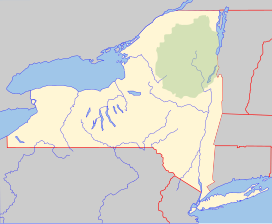| Seward Mountain | |
|---|---|
 Seward Mt. seen from Seymour Mt. | |
| Highest point | |
| Elevation | 4,361 ft (1,329 m) NGVD 29[1] |
| Listing | |
| Coordinates | 44°9.58′N 74°11.98′W / 44.15967°N 74.19967°W[3] |
| Geography | |
| Location | Franklin County, New York |
| Parent range | Seward Mountains |
| Topo map | USGS Ampersand Lake |
| Climbing | |
| First ascent | October 15, 1870, by Verplanck Colvin and Alvah Dunning (first recorded)[4][a] |
Seward Mountain is a mountain located in Franklin County, New York, of which it is the highest point. Seward Mtn. is named after William H. Seward (1801–1872), Governor of New York (1839–1842), and United States Secretary of State (1861–1869). The mountain is part of the Seward Mountains of the Adirondacks. Seward Mountain is flanked to the southwest by Donaldson Mountain, and to the east faces Seymour Mountain across Ouluska Pass.
Seward Mountain stands within the watershed of the Raquette River, which drains into the Saint Lawrence River in Canada, and into the Gulf of Saint Lawrence. The southeast slopes of Seward Mtn. drain into Seward Brook, thence into the Cold River, a tributary of the Raquette River. The west end of Seward Mtn. drains into Calkins Brook, thence into the Raquette River. The northern slopes of Seward drain into Ward Brook, thence into Ampersand Lake, Ampersand Brook, Stony Creek, and the Raquette River.
Seward Mountain is within the High Peaks Wilderness Area of New York's Adirondack Park.
- ^ Goodwin, Tony, ed. (2021). Adirondack trails. High peaks region (15th ed.). Adirondack Mountain Club. pp. 286–287. ISBN 9780998637181.
- ^ "The Peaks – Adirondack 46ers". adk46er.org. Retrieved 28 May 2024.
- ^ "Seward Mountain". Geographic Names Information System. United States Geological Survey, United States Department of the Interior. Retrieved 28 May 2024.
- ^ Terrie, Phillip G., Contested Terrain; A New History of Nature and People in the Adirondacks, Syracuse: Adirondack Museum/Syracuse University Press, 1997. ISBN 978-0-8156-0904-9.
- ^ Carson, Russell M. L. (1927). Peaks and People of the Adirondacks. Garden City: Doubleday. pp. 213–217. ISBN 9781404751200.
Cite error: There are <ref group=lower-alpha> tags or {{efn}} templates on this page, but the references will not show without a {{reflist|group=lower-alpha}} template or {{notelist}} template (see the help page).

